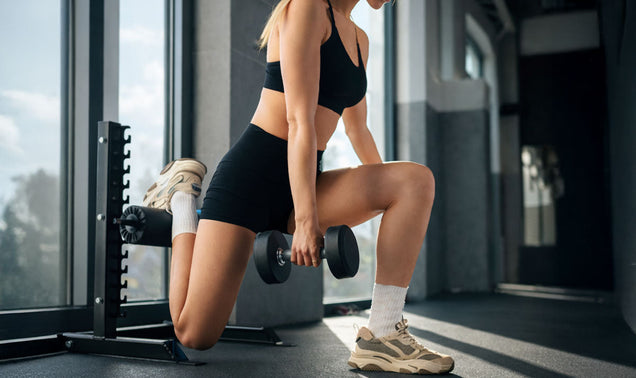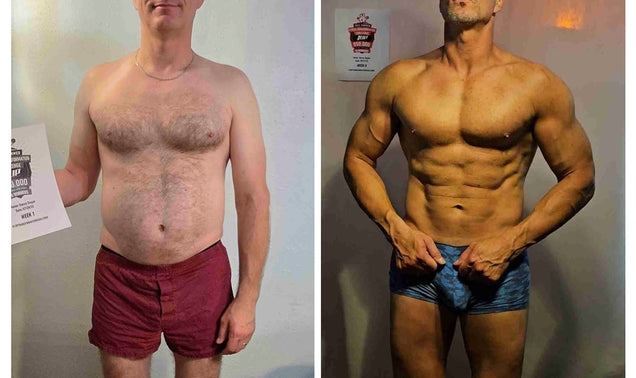Much of the focus of being strong, healthy, and fit is in regards to how much muscle vs how much fat we carry. And while this is certainly important to our overall health, wellness, and longevity, there’s another aspect to our ability to live pain-free that’s often ignored -- joint health.
Our joints are links between two bones that allow us to move the way we do, and strong, healthy joints are essential to moving freely without stiffness, pain, and discomfort.
Today, we discuss the importance of joint health as well as what you can do to promote stronger, healthier, better functioning joints as you age.
Joint Structure 101
Joints are the points in the body where two bones meet. They’re usually classified according to their structure or function. If grouping joints according to their structure, they are broken out as follows:
- Cartilaginous joint -- joined by cartilage and allow little movement, examples are the spine and ribs
- Facet joint -- joined between two articular processes in your spine that allow you to bend and twist as well as make your back flexible
- Fibrous joint – joined by dense connective tissue consisting primarily of collagen fibers[1]
- Synovial joint -- most common type of joint in the body and allows for more movement of articulating bones. Common examples are ball-and-socket joints (like the shoulder joint) and hinge joints (such as those found in the knee and elbow).
However, if they’re classified according to function, joints fall into one of the three following categories based on how much and what kind of movement they allow:
- Amphiarthrosis – allows little mobility. Examples are intervertebral discs of the spine which act as “shock absorbers”.
- Synarthrosis -- allows little to no movement. Examples are the fibrous joints that connect the bones of the skull
- Synovial -- filled with synovial fluid and allows the greatest range of motion. Examples are the knees, shoulders, hips, elbows, hands, and ankles.
While all joints serve their purpose, the ones we’re typically most interested in preserving the integrity of with respect to working out are the synovial joints.
Synovial joints are surrounded by joint capsule (synovium) that creates a thick liquid called synovial fluid that nourishes and lubricates the joint. Surrounding the joint capsule are ligaments that hold the joint together, allowing for fluid joint movement, and helping to prevent dislocation of the joint.
Now, another important component to joint health and smooth function is cartilage.
Cartilage is a smooth elastic tissue that covers and protects the ends of bones where it acts as a type of rubber-like padding for the joint so that bone doesn’t touch bone and they are allowed to move freely.[2]
Collagen is the Key
At the center of all of these connective tissues (bones, muscles, ligaments, and tendons) is an highly important structural protein called collagen.
Our bodies naturally produce collagen every day; however, as we age, our ability to efficiently synthesize new collagen everyday declines. And without sufficient collagen production, these connective tissues weaken, leading to achy joints and weak, brittle bones.
Once substantial tissue breakdown occurs in our cartilage, bones contact one another, leading to additional pain and inflammation in and around our joints. The longer these bones continue to rub and scrape against each other, the bone ends become thick and develop osteophytes (bone spurs).
How to Improve Joint and Cartilage Recovery
The most effective way to care for your joints is basically the same way you keep the rest of your body healthy -- proper diet and exercise!
Engaging in resistance training, using proper technique and a full range of motion help reduce joint stiffness, keeping them flexible and well-lubricated.[3] Regular exercise also helps build muscle and strength. Muscle acts as a form of protection for our bones in the case of collisions. The bigger and stronger your muscles are, the more resilient your skeleton is as it has a bigger “buffer” to protect it.
Diet is also important to maintaining healthy joints and cartilage and they provide the proteins and amino acids (like collagen, glycine, etc) the body needs to repair the existing structures and strengthen them.
Unfortunately, most Western diets do not have high intakes of foods rich in collagen like bone broth and organ meats.
The Best Supplements for Joint and Cartilage Recovery
This is when having a collagen supplement can come in handy. Numerous studies have shown that supplementing with hydrolyzed collagen, like the kind contained in 1UP Nutrition Grass-Fed Collagen Peptides, helps reduce joint pain and provides improvement in joint function in both healthy individuals as well as those with osteoarthritis.[4,5,6,7]
Collagen supplements supply the body with valuable protein and amino acids, including glycine and proline, which support the body’s production of the important structural protein as well as increase the synthesis of extracellular matrix.
In addition to collagen, a number of all natural supplements created specifically to help reduce joint pain and enhance joint mobility and function have been developed to help those looking to support their joints.
For instance, 1UP Nutrition His BCAA’s contains a full joint support complex which includes both Type II Collagen and Hyaluronic acid.
In case you weren’t aware, type II collagen is a specific type of collagen responsible for the strength and toughness in the cartilage. Research has shown that supplementing with type II collagen may help alleviate symptoms associated with osteoarthritis.[8]
Hyaluronic acid is a gooey substance naturally produced by the body which helps cushion and lubricate joints and other connective tissues. Studies note that supplementation with hyaluronic acid helps reduce joint pain, and it may also speed wound healing and the appearance of your skin.[9,10]
1UP Nutrition also includes a full 2 grams of collagen in every serving of their women’s intra workout supplement Her BCAA’s to support joint health, structure, and function.
Takeaway
Our joints are what allow us to move freely, and taking care of them must be a priority if we intend to live pain-free as we age. Supporting joint health is best accomplished through a mixture of a well-balanced diet and physical activity. Joint supplements, like collagen and hyaluronic acid, can help offer added support for joints, making them stronger and more resilient as well as helping to alleviate pain often associated with problematic joints.
References
- Principles of Anatomy & Physiology, 12th Edition, Tortora & Derrickson, Pub: Wiley & Sons
- Newton-Triggs, L., & Rogers, J. (2014). The musculoskeletal system and human movement. Orthopaedic and Trauma Nursing: An Evidence-based Approach to Musculoskeletal Care, 27
- Klaasen, R., Wijbrandts, C. A., Gerlag, D. M., & Tak, P. P. (2011). Body mass index and clinical response to infliximab in rheumatoid arthritis. Arthritis & Rheumatism, 63(2), 359-364.
- Collagen supplementation as a complementary therapy for the prevention and treatment of osteoporosis and osteoarthritis : a systematic review. (2016), 153–164.
- Bello, A. E., & Oesser, S. (2006). Collagen hydrolysate for the treatment of osteoarthritis and other joint disorders: a review of the literature. Current Medical Research and Opinion, 22(11), 2221–2232. https://doi.org/10.1185/030079906X148373
- Moskowitz, R. W. (2000). Role of collagen hydrolysate in bone and joint disease. Seminars in Arthritis and Rheumatism, 30(2), 87–99. https://doi.org/10.1053/sarh.2000.9622
- Clark, K. L., Sebastianelli, W., Flechsenhar, K. R., Aukerman, D. F., Meza, F., Millard, R. L., Albert, A. (2008). 24-Week study on the use of collagen hydrolysate as a dietary supplement in athletes with activity-related joint pain. Current Medical Research and Opinion, 24(5), 1485–1496. https://doi.org/10.1185/030079908X291967
- Bakilan F, Armagan O, Ozgen M, Tascioglu F, Bolluk O, Alatas O. Effects of Native Type II Collagen Treatment on Knee Osteoarthritis: A Randomized Controlled Trial. Eurasian J Med. 2016;48(2):95–101. doi:10.5152/eurasianjmed.2015.15030
- Tashiro T, Seino S, Sato T, Matsuoka R, Masuda Y, Fukui N. Oral administration of polymer hyaluronic acid alleviates symptoms of knee osteoarthritis: a double-blind, placebo-controlled study over a 12-month period. ScientificWorldJournal. ;2012:167928. doi:10.1100/2012/167928
- Oe M, Tashiro T, Yoshida H, et al. Oral hyaluronan relieves knee pain: a review. Nutr J. 2016;15:11. Published 2016 Jan 27. doi:10.1186/s12937-016-0128-2






